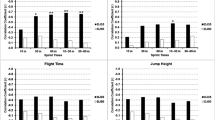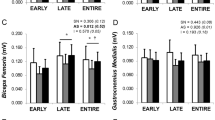Abstract
Sprint mechanics and field 100-m performances were tested in 13 subjects including 9 non-specialists, 3 French national-level sprinters and a world-class sprinter, to further study the mechanical factors associated with sprint performance. 6-s sprints performed on an instrumented treadmill allowed continuous recording of step kinematics, ground reaction forces (GRF), and belt velocity and computation of mechanical power output and linear force–velocity relationships. An index of the force application technique was computed as the slope of the linear relationship between the decrease in the ratio of horizontal-to-resultant GRF and the increase in velocity. Mechanical power output was positively correlated to mean 100-m speed (P < 0.01), as was the theoretical maximal velocity production capability (P < 0.011), whereas the theoretical maximal force production capability was not. The ability to apply the resultant force backward during acceleration was positively correlated to 100-m performance (r s > 0.683; P < 0.018), but the magnitude of resultant force was not (P = 0.16). Step frequency, contact and swing time were significantly correlated to acceleration and 100-m performance (positively for the former, negatively for the two latter, all P < 0.05), whereas aerial time and step length were not (all P > 0.21). Last, anthropometric data of body mass index and lower-limb-to-height ratio showed no significant correlation with 100-m performance. We concluded that the main mechanical determinants of 100-m performance were (1) a “velocity-oriented” force–velocity profile, likely explained by (2) a higher ability to apply the resultant GRF vector with a forward orientation over the acceleration, and (3) a higher step frequency resulting from a shorter contact time.



Similar content being viewed by others
References
Arsac LM, Locatelli E (2002) Modeling the energetics of 100-m running by using speed curves of world champions. J Appl Physiol 92:1781–1788
Baguet A, Everaert I, Hespel P, Petrovic M, Achten E, Derave W (2011) A new method for non-invasive estimation of human muscle fiber type composition. PLoS ONE 6:e21956
Bejan A, Jones EC, Charles JD (2010) The evolution of speed in athletics: why the fastest runners are black and swimmers white. Int J Des Nat 5:1–13
Beneke R, Taylor MJD (2010) What gives Bolt the edge—A.V. Hill knew it already! J Biomech 43:2241–2243
Best CH, Partridge RC (1928) The equation of motion of a runner, exerting a maximal effort. Proc R Soc B 103:218–225
Bret C, Messonnier L, Nouck Nouck JM, Freund H, Dufour AB, Lacour J-R (2003) Differences in lactate exchange and removal abilities in athletes specialised in different track running events (100 to 1500 m). Int J Sports Med 24:108–113
Bundle MW, Hoyt RW, Weyand PG (2003) High-speed running performance: a new approach to assessment and prediction. J Appl Physiol 95:1955–1962
Chelly SM, Denis C (2001) Leg power and hopping stiffness: relationship with sprint running performance. Med Sci Sports Exerc 33:326–333
Cormie P, McGuigan MR, Newton RU (2011) Developing maximal neuromuscular power: part 2—training considerations for improving maximal power production. Sports Med 41:125–146
Coyle EF (2005) Improved muscular efficiency displayed as Tour de France champion matures. J Appl Physiol 98:2191–2196
Cronin J, Hansen KT (2005) Strength and power predictors of sports speed. J Strength Cond Res 19:349–357
Cronin J, Sleivert G (2005) Challenges in understanding the influence of maximal power training on improving athletic performance. Sports Med 35:213–234
Di Prampero PE, Fusi S, Sepulcri L, Morin JB, Belli A, Antonutto G (2005) Sprint running: a new energetic approach. J Exp Biol 208:2809–2816
Dorel S, Couturier A, Lacour J-R, Vandewalle H, Hautier C, Hug F (2010) Force–velocity relationship in cycling revisited: benefit of two-dimensional pedal forces analysis. Med Sci Sports Exerc 42:1174–1183
Frishberg BA (1983) An analysis of overground and treadmill sprinting. Med Sci Sports Exerc 15:478–485
Furusawa K, Hill AV, Parkinson JL (1927) The energy used in “sprint” running. Proc R Soc B 102(713):43–49
Gollnick PD, Matoba H (1984) The muscle fiber composition of skeletal muscle as a predictor of athletic success. An overview. Am J Sports Med 12:212–217
Harris NK, Cronin J, Hopkins WG, Hansen KT (2008) Relationship between sprint times and the strength/power outputs of a machine squat jump. J Strength Cond Res 22:691–698
Hirvonen J, Rehunen S, Rusko H, Harkonen M (1987) Breakdown of high-energy phosphate compounds and lactate accumulation during short supramaximal exercise. Eur J Appl Physiol Occup Physiol 56:253–259
Hunter JP, Marshall RN, McNair PJ (2005) Relationships between ground reaction force impulse and kinematics of sprint-running acceleration. J Appl Biomech 21:31–43
Jaskolska A, Goossens P, Veenstra B, Jaskolski A, Skinner JS (1999) Treadmill measurement of the force–velocity relationship and power output in subjects with different maximal running velocities. Sports Med Train Rehab 8:347–358
Jones AM (2006) The physiology of the world record holder for the women’s marathon. Int J Sports Sci Coach 1:101–116
Karamanidis K, Albracht K, Braunstein B, Catala MM, Goldmann JP, Bruggemann GP (2011) Lower leg musculoskeletal geometry and sprint performance. Gait Posture 34:138–141
Kivi DM, Maraj BK, Gervais P (2002) A kinematic analysis of highspeed treadmill sprinting over a range of velocities. Med Sci Sports Exerc 34:662–666
Lacour J-R, Messonnier L, Bourdin M (2009) Physiological correlates of performance. Case–study of a world-class rower. Eur J Appl Physiol 106:407–413
Lucia A, Olivan J, Bravo J, Gonzalez-Freire M, Foster C (2008) The key to top-level endurance running performance: a unique example. Br J Sports Med 42:172–174
McMahon TA, Green PR (1979) The influence of track compliance on running. J Biomech 12:893–904
Mero A, Komi PV (1986) Force-, EMG-, and elasticity–velocity relationships at submaximal, maximal and supramaximal running speeds in sprinters. Eur J Appl Physiol Occup Physiol 55:553–561
Moravec P, Ruzicka J, Susanka P, Dostal E, Kodejs M, Nosek M (1988) The 1987 International Amateur Athletic Federation/IAAF Scientific Project Report: time analysis of the 100 meters events at the II World Championships in Athletics. New Stud Athl 3:61–96
Morin JB, Sève P (2011) Sprint running performance: comparison between treadmill and field conditions. Eur J Appl Physiol 111:1695–1703
Morin JB, Hintzy F, Belli A, Grappe F (2002) Force–velocity relationships and sprint running performances in trained athletes. Sci Sport 17:78–85 (French)
Morin JB, Samozino P, Bonnefoy R, Edouard P, Belli A (2010) Direct measurement of power during one single sprint on treadmill. J Biomech 43:1970–1975
Morin JB, Edouard P, Samozino P (2011a) Technical ability of force application as a determinant factor of sprint performance. Med Sci Sports Exerc 43:1680–1688
Morin JB, Samozino P, Edouard P, Tomazin K (2011b) Effect of fatigue on force production and force application technique during repeated sprints. J Biomech 44:2719–2723
Rahmani A, Locatelli E, Lacour JR (2004) Differences in morphology and force/velocity relationship between Senegalese and Italian sprinters. Eur J Appl Physiol 91:399–405
Roberts TJ, Scales JA (2002) Mechanical power output during running accelerations in wild turkeys. J Exp Biol 205:1485–1494
Salo AI, Bezodis IN, Batterham AM, Kerwin DG (2011) Elite sprinting: are athletes individually step frequency or step length reliant? Med Sci Sports Exerc 43:1055–1062
Samozino P, Rejc E, Di Prampero PE, Belli A, Morin JB (2012) Optimal force–velocity profile in ballistic movements. Altius: citius or fortius? Med Sci Sports Exerc 44:313–322
Sleivert G, Taingahue M (2004) The relationship between maximal jump-squat power and sprint acceleration in athletes. Eur J Appl Physiol 91:46–52
van Ingen Schenau GJ, de Koning JJ, de Groot G (1994) Optimisation of sprinting performance in running, cycling and speed skating. Sports Med 17:259–275
Volkov NI, Lapin VI (1979) Analysis of the velocity curve in sprint running. Med Sci Sports 11:332–337
Ward-Smith AJ, Radford PF (2000) Investigation of the kinetics of anaerobic metabolism by analysis of the performance of elite sprinters. J Biomech 33:997–1004
Watts AS, Coleman I, Nevill A (2011) The changing shape characteristics associated with success in world-class sprinters. J Sports Sci. doi:10.1080/02640414.2011.588957
Weyand PG, Davis JA (2005) Running performance has a structural basis. J Exp Biol 208:2625–2631
Weyand PG, Sternlight DB, Bellizzi MJ, Wright S (2000) Faster top running speeds are achieved with greater ground forces not more rapid leg movements. J Appl Physiol 89:1991–1999
Weyand PG, Bundle MW, McGowan CP, Grabowski A, Brown MB, Kram R, Herr H (2009) The fastest runner on artificial legs: different limbs, similar function? J Appl Physiol 107:903–911
Weyand PG, Sandell RF, Prime DNL, Bundle MW (2010) The biological limits to running speed are imposed from the ground up. J Appl Physiol 108:950–961
Acknowledgments
We are very grateful to Pierre Carraz and the athletes of the AS Aix-les-Bains Track and Field club for their involvement in the protocol. We also thank Johan Cassirame (Matsport, France), Thibault Lussiana and Nicolas Tordi (Centre d’Optimisation de la Performance Sportive COPS, Université de Franche-Comté, France) and Mathieu Lacome and Olivier Rambaud for their precious help in field and laboratory data collection. We also gratefully thank the two anonymous reviewers for their supportive and constructive comments.
Conflict of interest
None.
Author information
Authors and Affiliations
Corresponding author
Additional information
Communicated by Guido Ferretti.
Rights and permissions
About this article
Cite this article
Morin, JB., Bourdin, M., Edouard, P. et al. Mechanical determinants of 100-m sprint running performance. Eur J Appl Physiol 112, 3921–3930 (2012). https://doi.org/10.1007/s00421-012-2379-8
Received:
Accepted:
Published:
Issue Date:
DOI: https://doi.org/10.1007/s00421-012-2379-8




